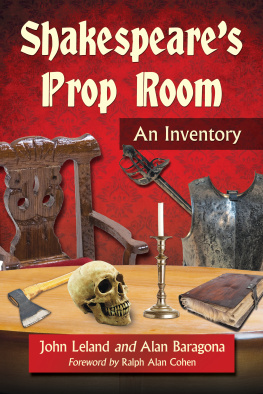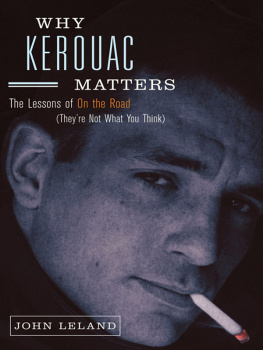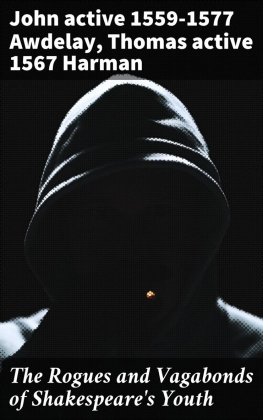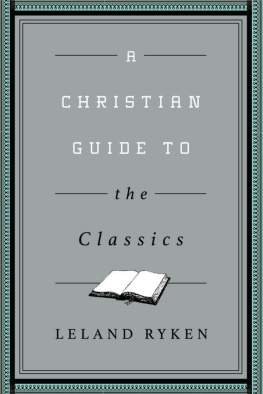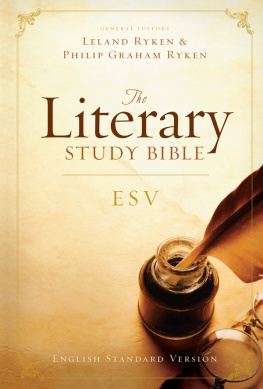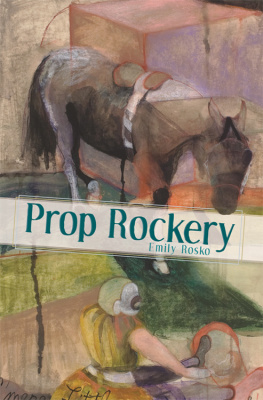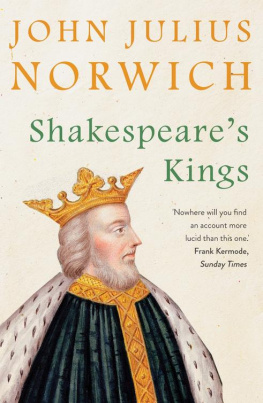John Leland - Shakespeares Prop Room
Here you can read online John Leland - Shakespeares Prop Room full text of the book (entire story) in english for free. Download pdf and epub, get meaning, cover and reviews about this ebook. genre: Non-fiction. Description of the work, (preface) as well as reviews are available. Best literature library LitArk.com created for fans of good reading and offers a wide selection of genres:
Romance novel
Science fiction
Adventure
Detective
Science
History
Home and family
Prose
Art
Politics
Computer
Non-fiction
Religion
Business
Children
Humor
Choose a favorite category and find really read worthwhile books. Enjoy immersion in the world of imagination, feel the emotions of the characters or learn something new for yourself, make an fascinating discovery.
- Book:Shakespeares Prop Room
- Author:
- Genre:
- Rating:4 / 5
- Favourites:Add to favourites
- Your mark:
- 80
- 1
- 2
- 3
- 4
- 5
Shakespeares Prop Room: summary, description and annotation
We offer to read an annotation, description, summary or preface (depends on what the author of the book "Shakespeares Prop Room" wrote himself). If you haven't found the necessary information about the book — write in the comments, we will try to find it.
Shakespeares Prop Room — read online for free the complete book (whole text) full work
Below is the text of the book, divided by pages. System saving the place of the last page read, allows you to conveniently read the book "Shakespeares Prop Room" online for free, without having to search again every time where you left off. Put a bookmark, and you can go to the page where you finished reading at any time.
Font size:
Interval:
Bookmark:

Foreword by Ralph Alan Cohen

McFarland & Company, Inc., Publishers
Jefferson, North Carolina
LIBRARY OF CONGRESS CATALOGUING DATA ARE AVAILABLE
BRITISH LIBRARY CATALOGUING DATA ARE AVAILABLE
e-ISBN: 978-1-4766-2343-6
2016 John Leland and Alan Baragona. All rights reserved
No part of this book may be reproduced or transmitted in any form or by any means, electronic or mechanical, including photocopying or recording, or by any information storage and retrieval system, without permission in writing from the publisher.
Front cover images 2016 iStock
McFarland & Company, Inc., Publishers
Box 611, Jefferson, North Carolina 28640
www.mcfarlandpub.com
From John to my sisters, weird and otherwise,
and
from Alan to Kathy, for always propping me up
We would like to thank the following people and institutions for their invaluable assistance:
Alston Cobourn, assistant professor and digital scholarship librarian, and Yolanda Merrill, associate professor and humanites librarian, at Washington and Lee University, who were diligent and tenacious in helping us track down images for the book.
Sarah Enloe, director of education, and Christopher Moneymaker, properties master, of the American Shakespeare Center, who were generous with their time and advice and provided the images of the Blackfriars Playhouse stage and of a variety of props.
John Donnes effigy in St. Pauls Cathedral.
Shakespeares bust in Stratford-upon-Avon.
Claes Visschers 1616 View of London includes London Bridge with the heads of traitors on display.
Reginald Scots 1584 The Discoverie of Witchcraft, with an illustration of a trick table.
George Turbeviles 1575 The Book of Faulconrie or Hawking, with a hawk.
Claes Visschers 1616 View of London includes the Globe Theater and the Bear Garden.
Thomas Dekkers 1608 The Belman of London, a cony-catching pamphlet.
Illustration from Turbeviles 1575 The Noble Art of Venerie, with a basket almost large enough to carry Falstaff in.
Frontispiece detail from William Alabasters 1630 Roxana showing a curtained discovery room.
Johannes de Witts ca. 1600 sketch of the Swan Theatre, with stage pillars as trees.
Illustration to Thomas Kyds The Spanish Tragedy showing Horatio hung in a stage arbor.
J. de Gheyns 1608 Maniement dArmes showing a soldier with a pike.
G. Swetnams 1617 The Schoole of Defence showing a short sword and dagger against a rapier and dagger.
Walter Godfreys 1911 reconstruction of the Fortune Theater, with what could be a balcony or battlement.
Caspar Rutz 1581 Habitas Variarum Orbis Gentium includes soldiers bearing swords, firearms and a pike.
G. Markhams 1634 The Art of Archerie showing a bow and arrow.
Francis Kirkmans 1662 The Wits, or Sport for Sport frontispiece showing Falstaff.
Blackfriars Playhouse interior, Staunton, Virginia.
Gascoigne presents his book to Queen Elizabeth.
John Meltons 1620 Astrologaster depicts properties possibly to be seen in The Tempest.
Clown Richard Tarleton with pipe and tabor like those of Ariel in The Tempest.
Clown William Kemp is shown dancing accompanied by pipe and tabor to Norwich.
Edmund Spensers 1579 The Shepheardes Calender includes a shepherds crook and a net.
Caspar Rutz 1581 Habitas Variarum Orbis Gentium includes figures with gloves and a fan.
James I on a throne with crown, rod, and orb.
In The Tempest, Prospero discovers 2 persons playing chess.
Twenty years ago the Shenandoah Shakespeare Express (now the American Shakespeare Center) ran an NEH summer institute for professors and producers of Shakespeare that we called the Center for Renaissance and Shakespearean Staging. We chose that name because we felt that the acronymC.R.A.S.S.sums up the kind of thinking scholars need to develop in understanding the plays of Shakespeare and his contemporaries. Shakespeare the poet can dream up the idea of a melancholy prince talking with a deaths head beside an open grave, but Shakespeare the playwrightthe maker of playshas to calculate the cost and availability of everything on the stage from paying the extra gravedigger to finding the skulls. Crass considerations.
Crass considerations can get us deeper into the plays. In Yoricks case, it makes us wonder why, given the material challenges, the playwright wanted more than one gravedigger or more than one skull. Students of Shakespeare should be asking questions like that and so should performers, because the answers to those sorts of questions get us closer to the genius of Shakespeare the maker of plays. That desire to get closer to the works is what lies behind the re-creation of the Globe in London and our Blackfriars Playhouse in Staunton. What might a show have looked like? What was on the stage? Where on the stage were the actors? What were they wearing? What were they holding? What objects were they dealing with?
And that is the question that Shakespeares Props asks so well, a question that unlocks so much. For beyond that question, John Leland and Alan Baragona have written and organized their book to be useful both to theorists and practitioners; it is a book that points but does not push the reader toward answers. The subject of Shakespeares Prop Room is material in both senses of that word: first, it is material to an understanding of the plays and matters to the production of a performance; but second, it is material because it is about matter, about things. Hamlet tells us that the plays the thing, and this book suggests that, when it comes to understanding how the play worked, it might be said that on occasion the things the play.
Professor Ralph Alan Cohen is co-founder and director of mission at the American Shakespeare Center, founder of the Master of Letters and Fine Arts program at Mary Baldwin College, and the author of ShakesFear and How to Cure It: A Handbook for Teaching Shakespeare. In 2014, he became the first American to receive the Globe Theatres prestigious Sam Wannamaker Award for promoting the understanding of Shakespeare.
Hamlet: Do you see nothing there?
Queen: Nothing at all, yet all there is I see [3.4.13132].
Shakespeares Romeo and Juliet culminates in what Juliet describes as:
an ancient receptacle,
Where for this many hundred years the bones
Of all my buried ancestors are packd,
Where bloody Tybalt, yet but green in earth,
Lies festring in his shroud, where, as they say,
At some hours in night spirits resort [4.3.3944].
Romeo enters armed with a mattock, and a crow of iron (5.3.21 s.d.), and later Friar Lawrence with crow, and spade (5.3.120 s.d.), both intent on opening the tomb. Romeo kills and then says to Paris, Ill bury thee in a triumphant grave (5.3.83), questions a dead Tybalt, liest thou there in thy bloody sheet? (5.3.97), and comes upon a seeming dead Juliet. Lines later, Friar Lawrence enters the tomb, as well. Anyone with half an imagination can conjure the Capulet family tomb, crammed with bodies alive and dead. But what did Shakespeares audience see? Did the Chamberlains Men build a temporary tomb on center stage large enough to hold Tybalt, Paris, Romeo, Juliet, and Friar Lawrence? Did they use the discovery space in the center of the tiring-house wall that backed the Globes stage, a space perhaps alluded to in the stage directions for Juliets burial, shutting the curtains (4.5.95)? Shakespeare contemporary theatre manager Philip Henslowe compiled a list of his stage properties that included, a rock, a cage, a tomb, a Hell mouth, a tomb of Guido, tomb of Dido, so some sort of property is within reason, and one editor of
Next pageFont size:
Interval:
Bookmark:
Similar books «Shakespeares Prop Room»
Look at similar books to Shakespeares Prop Room. We have selected literature similar in name and meaning in the hope of providing readers with more options to find new, interesting, not yet read works.
Discussion, reviews of the book Shakespeares Prop Room and just readers' own opinions. Leave your comments, write what you think about the work, its meaning or the main characters. Specify what exactly you liked and what you didn't like, and why you think so.

